Cemeteries offer unexpected winter wildlife havens with over 1,200 species to discover. You’ll spot European robins, winter thrushes, and even ladybirds among the gravestones. Bring quality binoculars, wear warm clothing, and observe respectfully from established paths. Record your sightings using apps like iRecord to contribute to the 9,800+ documented wildlife records. Berry-bearing shrubs and unmown areas with seed heads create perfect conditions for diverse bird activity throughout the colder months.
Numeric List of Second-Level Headings
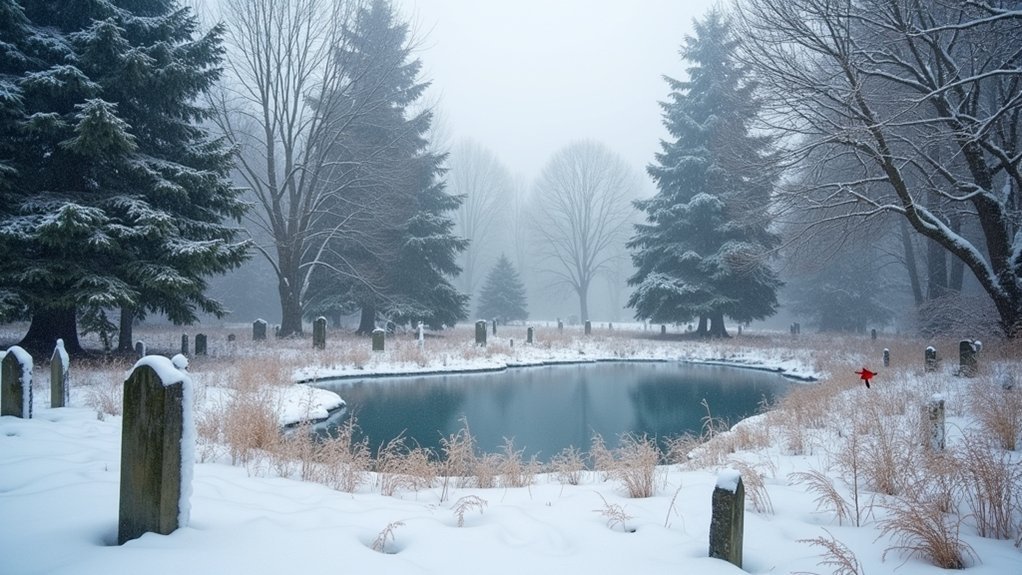
Five key sections will help you navigate your wildlife watching journey through cemetery habitats.
There’s a lot to discover in these overlooked sanctuaries:
- Essential Equipment & Preparation – What you’ll need before heading out
- Spotting Winter-Active Species – Focus on ladybirds and the 132 moth species visible without traps
- Recording Techniques – How to contribute to the 9,800+ wildlife records already documented
- Seasonal Highlights – When to find specific plants, beetles, and true bugs among the 1,200 species
- Community Science Opportunities – Joining bio blitzes and using identification resources to help discover rarities like Scotland’s new bark flies or Edinburgh’s scarce bug species
Each section provides practical guidance for maximizing your winter cemetery wildlife observations while supporting crucial conservation data collection.
Why Cemeteries Attract Winter Birds
Sanctuaries among the stones, cemeteries provide ideal winter habitats for birds when other urban areas offer limited resources.
You’ll find mature trees and diverse plant life offering vital shelter and food sources throughout the coldest months.
Unlike many urban spaces, cemeteries use fewer pesticides, creating healthier ecosystems where insects thrive—providing essential protein for wintering birds.
The abundance of shrubs with berries and seed-producing plants creates natural feeding stations you won’t find in more manicured parks.
Gravestones and monuments serve as perfect perches for birds, giving them vantage points to spot food and predators.
You’ll enjoy better birdwatching opportunities here as the reduced human activity makes birds less skittish and more visible than in busier green spaces.
Essential Equipment for Cemetery Bird Watching
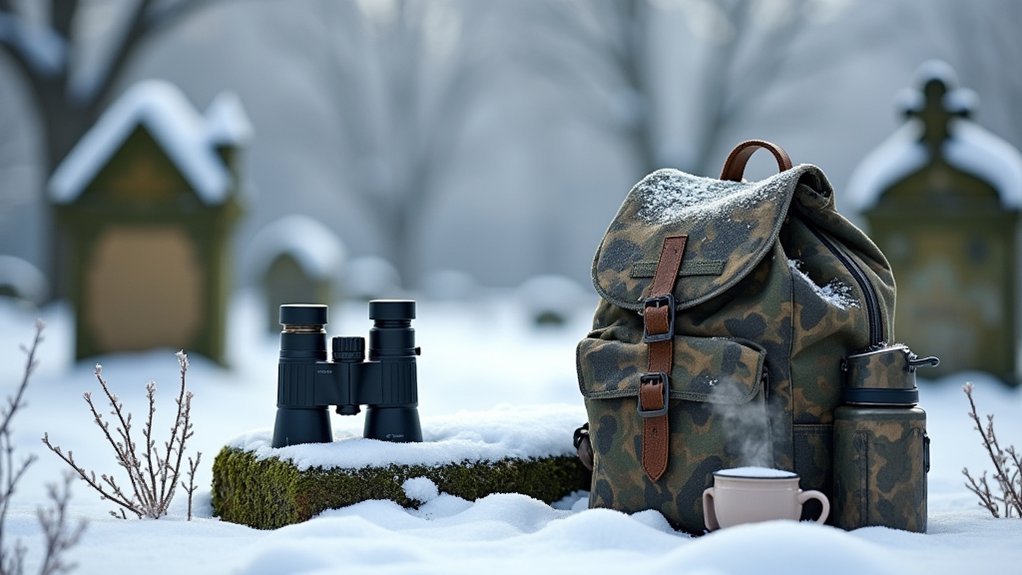
Preparation is key to successful cemetery bird watching during winter months. Equip yourself with quality binoculars (at least 8x magnification) to observe birds from a respectful distance without disturbing their natural behaviors.
Don’t forget a field guide or bird identification app to enhance your experience in these surprisingly diverse habitats.
For comfort and productivity during your cemetery visits, you’ll need:
- Warm, waterproof clothing and footwear to stay comfortable during extended observation periods
- A notebook or smartphone to record sightings, contributing valuable data to initiatives like Cemetery Wildlife Watch
- A camera with zoom capabilities to document species without approaching too closely
These tools will help you enjoy wildlife watching while respecting both the cemetery’s sanctity and the birds’ natural behaviors.
Respectful Observation Practices in Sacred Spaces
While cemeteries offer remarkable biodiversity and bird watching opportunities, they remain primarily places of remembrance and reflection.
Always maintain a respectful distance from graves and monuments as you observe wildlife, honoring the sacred nature of these spaces.
Follow cemetery-specific rules and guidelines, which often balance wildlife conservation with reverence for the deceased.
Keep noise to a minimum and move quietly, especially during winter when some insects remain active and easily disturbed.
Use non-invasive recording methods—observe from established paths and utilize apps like iRecord to document sightings without disturbing habitats.
Connect with the Cemetery Wildlife Watch community through their Facebook group to share experiences and learn proper etiquette from fellow enthusiasts.
This collaborative approach guarantees both wildlife and visitors can peacefully coexist.
Common Winter Bird Species in UK Cemeteries
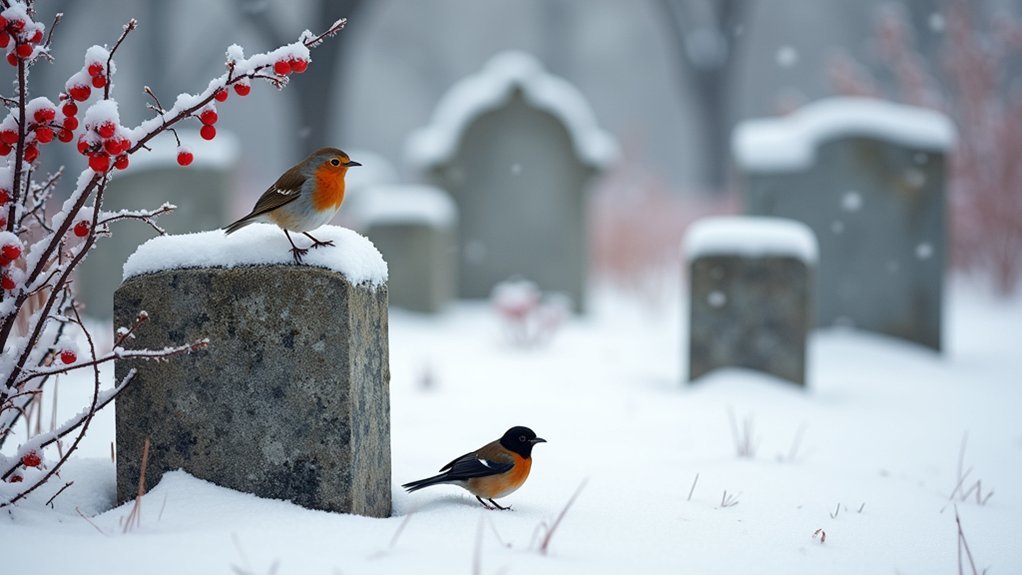
You’ll often encounter European robins with their vibrant red breasts flitting between gravestones, singing their melodious winter songs.
Look for great tits and blue tits moving through the cemetery’s shrubs and trees, where they find essential shelter and food sources during the harsh winter months.
Winter also brings thrush migrations to UK cemeteries, where blackbirds with their distinctive yellow eye-rings and orange bills can be spotted foraging around the grounds.
Robins Among Gravestones
Sentinels of winter solitude, robins bring vibrant life to the quiet corners of UK cemeteries during the coldest months. Their red-orange breasts flash between headstones as they search for food, while their melodious song echoes through the peaceful grounds.
You’ll find these confident birds surprisingly approachable as you explore cemetery paths. They’ve adapted well to human presence, making them perfect subjects for wildlife photography and observation.
For successful robin spotting, remember:
- Listen for their distinctive winter song—they’re one of few birds that sing year-round.
- Look among mature trees and shrubs where they forage for insects and berries.
- Move slowly and quietly; though bold, sudden movements may startle them.
These cemetery dwellers contribute greatly to urban biodiversity records, helping conservationists monitor wildlife in our green spaces.
Tits and Shrub Habitat
Robins aren’t the only feathered characters bringing life to cemetery grounds during winter months. As you wander among the headstones, you’ll likely spot the vibrant flash of Great Tits and Blue Tits flitting between mature trees and dense shrubbery.
These adaptable birds thrive in cemetery environments, where minimal pesticide use and diverse plant life create perfect foraging conditions. You’ll find them busily searching for insects, seeds, and berries that sustain them through the cold season.
The undisturbed nature of these sacred spaces provides tits with natural shelter from harsh weather, contributing to their significantly robust populations.
Cemetery Wildlife Watch has documented approximately 1,200 species across UK burial grounds, making these locations excellent spots for winter birdwatching. The peaceful setting offers you unique opportunities to observe these colorful birds in action.
Winter Thrush Migrations
When winter tightens its grip across Scandinavia and Northern Europe, thousands of thrushes commence on their annual migration to British shores, with many finding sanctuary in the peaceful grounds of UK cemeteries.
These undisturbed green spaces offer perfect foraging conditions for species like Redwings and Fieldfares.
You’ll easily identify these winter visitors by noting:
- Redwings – Look for their distinctive white eye stripe and vibrant orange-red flanks as they search for berries.
- Fieldfares – Spot their grayish-brown backs and black tails as they forage in small flocks.
- Foraging behavior – Watch for them actively searching through fallen leaves and congregating around fruit-bearing trees.
Cemetery habitats provide these migrants essential protection from harsh conditions and predators, while contributing markedly to local biodiversity records during winter months.
Identifying Bird Tracks and Signs in Snow
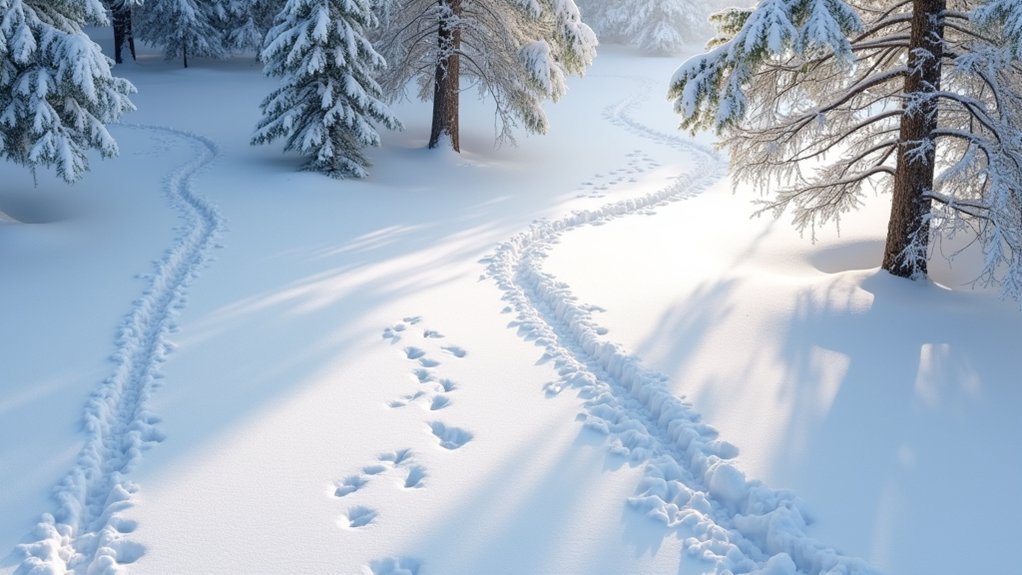
Exploring a snowy landscape reveals a fascinating record of avian activity that you might otherwise miss during winter months. As you wander through cemetery grounds, look for varying impressions in the snow—crow tracks sink deeper while sparrow marks appear delicate and light.
Notice how tracks tell stories of bird behavior: hopping birds leave closely spaced prints, while walking birds show wider strides. Most songbirds display a distinctive pattern of three forward toes and one backward toe.
| Bird Type | Track Pattern | Additional Signs |
|---|---|---|
| Sparrows | Tiny, close-set | Seed hulls, small droppings |
| Robins | Medium, hopping | Turned leaves, berry remains |
| Crows | Large, walking | Larger droppings, scattered food |
| Woodpeckers | Paired tracks | Bark chips, hole drillings |
| Cardinals | Medium, hopping | Sunflower seed shells |
Don’t overlook other evidence—scattered feathers and different dropping types provide valuable identification clues.
Best Times of Day for Cemetery Bird Activity
While tracking bird signs in snow offers valuable insights into their presence, understanding when birds are most active enhances your chances of direct observation. In cemetery environments, timing is everything for successful birdwatching.
The prime windows for cemetery bird activity are:
- Early morning – Just after sunrise provides ideal viewing as birds actively forage and sing in the mature trees and varied vegetation.
- Dusk hours – Before sunset offers another peak period when species emerge again to feed and prepare for roosting.
- Seasonal adjustments – Winter brings different species than spring or summer, requiring adapted observation schedules.
Remember to maintain a quiet, unobtrusive presence during these peak times – you’ll be rewarded with closer encounters in these peaceful sanctuaries.
How Cemetery Vegetation Supports Winter Birds
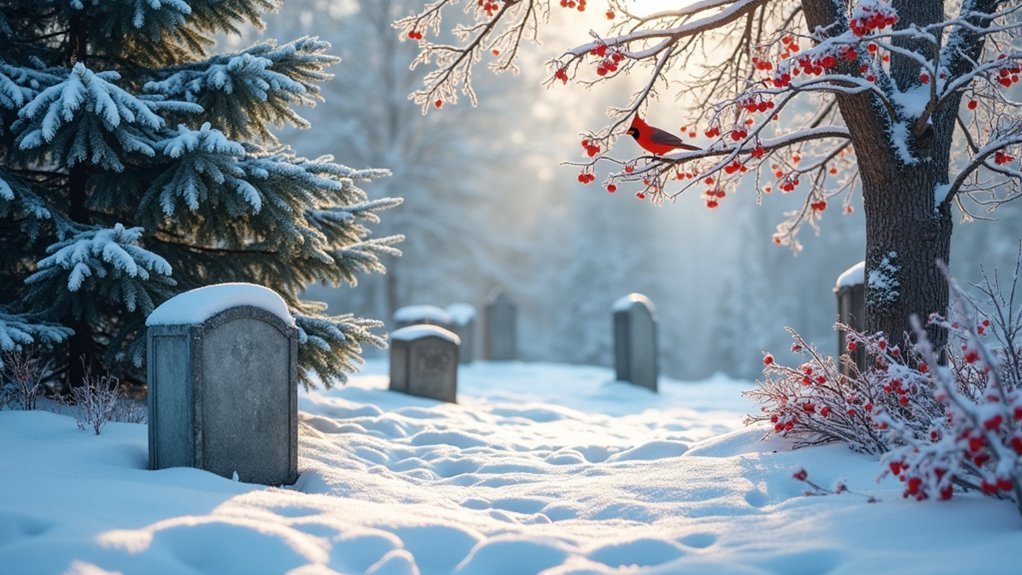
You’ll find berry-bearing shrubs in cemeteries providing essential food sources that attract various winter bird species when other options are scarce.
Unmown areas with dried seed heads sustain life through the coldest months, offering natural nutrition that many ground-feeding birds depend on.
The cemetery’s mature evergreens offer critical shelter from harsh winter elements, creating protected spaces where birds can conserve energy and escape predators.
Berry-Bearing Shrubs Attract
Dozens of berry-bearing shrubs found in cemetery landscapes create essential feeding grounds for winter birds when food sources become scarce.
You’ll notice these vibrant patches of color attract numerous species seeking sustenance during the coldest months.
When you’re wildlife watching in these peaceful sanctuaries, focus on areas with:
- Holly shrubs with bright red berries that provide high-energy food
- Mature yew trees offering sheltered perches near their abundant red arils
- Elder and hawthorn clusters where birds often gather in feeding flocks
The 9,800 wildlife records from cemetery grounds demonstrate the importance of these berry-rich habitats.
You can contribute valuable observations by noting which shrubs attract the most activity.
Cemetery management practices that preserve these natural feeding stations are vital for supporting winter bird populations through harsh weather.
Seed Heads Sustain Life
Goldfinches, juncos, and sparrows flock to the overlooked seed heads dotting cemetery landscapes throughout winter.
These flowering plant remnants provide critical nutrition when food sources elsewhere become scarce. You’ll notice birds perching on gravestones before darting to feast on native grasses and wildflowers, which thrive in these spaces where pesticides are rarely used.
Cemetery Wildlife Watch data confirms that areas with abundant seed heads attract more winter birds.
The unique combination of stone monuments and mature trees creates ideal foraging conditions, offering both shelter and vantage points for wary feeders.
Evergreens Provide Shelter
While seed heads provide nourishment, the towering evergreens throughout cemetery grounds offer birds something equally valuable—protection from winter’s harsh elements.
These mature conifers create essential microclimates where birds can escape biting winds and freezing temperatures. You’ll find these sanctuaries particularly rich in bird activity during the coldest months.
When visiting a cemetery for birdwatching, notice how the unique landscape supports winter survival:
- Dense evergreen branches shield birds from predators while blocking snow and wind
- Minimal pesticide use guarantees natural food sources remain abundant near these shelters
- Gravestone arrangements create additional windbreaks and thermal pockets where birds conserve energy
The combination of these features makes cemeteries exceptional winter habitats—often supporting greater bird diversity than surrounding urban areas.
Creating a Cemetery Bird Watching Journal
As you venture into cemetery bird watching, keeping a dedicated journal becomes an invaluable tool for both your enjoyment and scientific contribution.
Start by recording the date, time, and location of each visit to track seasonal patterns in bird activity.
Document every species you encounter, noting behaviors, population numbers, and preferred cemetery areas. These details help build understanding of avian biodiversity in these peaceful sanctuaries.
When identification challenges arise, utilize online resources and Cemetery Wildlife Watch Facebook groups where fellow enthusiasts can help confirm species.
Pay special attention to mature trees and shrubs, which attract diverse birds, especially during migration.
Don’t overlook interactions between bird species or with other wildlife—these observations provide valuable insights into the cemetery’s complex ecological relationships and behaviors.
Photography Tips for Cemetery Bird Documentation
Capturing birds through photography adds a rewarding dimension to cemetery wildlife watching that complements your written journal entries.
Position yourself strategically among gravestones and mature trees, using these natural elements as cover to approach birds without disturbing their natural behaviors.
For the best results in cemetery bird photography:
- Time your visits for early morning or late afternoon when birds are most active and golden light enhances your images.
- Use a zoom lens of at least 200mm to capture detailed shots while maintaining a respectful distance.
- Learn bird calls to anticipate movement and prepare for the perfect shot before you even see your subject.
Don’t forget to submit your photographic records to the Cemetery Wildlife Recording scheme, contributing valuable biodiversity data.
Connecting With Local Bird Watching Groups
Everyone benefits from shared knowledge when exploring cemetery wildlife. By joining local bird watching groups, you’ll gain valuable insights into winter-active species that frequent these peaceful sanctuaries.
These organizations regularly host cemetery walks and events where experienced birders share identification techniques for common residents like robins and sparrows.
Many groups offer workshops specifically designed to help you recognize distinctive bird calls and behaviors during winter months—a skill that’s particularly useful when foliage is sparse. Your participation contributes meaningfully to community science initiatives such as Cemetery Wildlife Watch, helping build important biodiversity records.
You’ll also connect with fellow nature enthusiasts who share your interest in wildlife conservation and cemetery biodiversity. These relationships enrich your bird watching experience while supporting collective efforts to protect these unique ecological havens.
Using Irecord to Document Cemetery Bird Sightings
Recording your cemetery bird sightings becomes remarkably straightforward with iRecord, the UK’s premier wildlife documentation platform. By registering for an account, you’ll join contributors to the impressive database of nearly 9,800 records from burial grounds, churchyards, and cemeteries across the country.
Your observations help local councils manage these spaces for wildlife conservation while enhancing our understanding of urban biodiversity.
Cemetery wildlife observations inform conservation management decisions while adding critical data to our urban ecology knowledge base.
To maximize your contribution:
- Utilize identification resources to guarantee accuracy in your submissions
- Coordinate with local recorders who can verify your sightings
- Participate in bio blitzes and other recording events to collect data alongside experienced naturalists
With birds currently underrepresented in cemetery wildlife records, your dedicated watching and documenting efforts are particularly valuable to the Cemetery Wildlife Watch initiative.
Winter Feeding Behaviors to Observe
While your bird sighting records contribute valuable data, the winter months offer particularly fascinating wildlife behaviors to document in cemetery settings.
Look for ladybirds clustering on gravestones and tree bark for warmth—their vibrant congregations create striking contrasts against stone surfaces.
You’ll spot robins and sparrows actively foraging among undergrowth and around monuments, searching for winter berries and seeds.
Don’t miss the hardy winter moths feeding on any available flowers or plant matter during milder days.
Cemeteries provide diverse microhabitats that support these winter feeding activities.
Watch for barkflies exhibiting parental care behaviors even in colder temperatures—a rare winter treat for patient observers.
The combination of sheltered spots and varied vegetation makes these peaceful spaces perfect for witnessing survival strategies unfold as wildlife adapts to winter conditions.
Frequently Asked Questions
Can Cemeteries Serve as Wildlife Corridors in Urban Landscapes?
Yes, cemeteries can serve as wildlife corridors in urban landscapes. You’ll find they provide essential green spaces that connect fragmented habitats, allowing animals to move safely through developed areas while seeking food and mates.
How Do Cemetery Management Practices Affect Winter Wildlife Diversity?
You’ll find that cemetery wildlife diversity in winter depends heavily on management practices like reduced snow clearing, leaving leaf litter, maintaining natural plantings, and minimizing chemical treatments that preserve critical habitat for overwintering species.
Are Night Visits Permitted for Observing Nocturnal Cemetery Wildlife?
Night visits are rarely permitted in cemeteries due to safety concerns and respect for the deceased. You’ll need to check each cemetery’s specific rules and potentially request special permission for nocturnal wildlife observation.
What Non-Bird Wildlife Species Commonly Inhabit Cemeteries in Winter?
In winter cemeteries, you’ll find squirrels, rabbits, foxes, raccoons, opossums, and sometimes deer. You might also spot chipmunks, voles, mice, and occasional coyotes seeking shelter among the quiet grounds and evergreen vegetation.
How Do Historic Versus Modern Cemeteries Differ in Wildlife Populations?
Historic cemeteries offer more wildlife due to their mature trees, overgrown sections, and minimal maintenance. You’ll find greater biodiversity there than in modern cemeteries with their manicured lawns and fewer habitat opportunities.
In Summary
You’ll find that cemetery bird watching offers a unique window into winter’s hidden wildlife world. By equipping yourself properly, practicing respectful observation, and connecting with fellow enthusiasts, you’ve discovered a peaceful sanctuary hiding in plain sight. Whether you’re photographing a robin on a gravestone or documenting rare visitors on iRecord, you’re participating in valuable conservation while honoring these sacred, vibrant spaces.

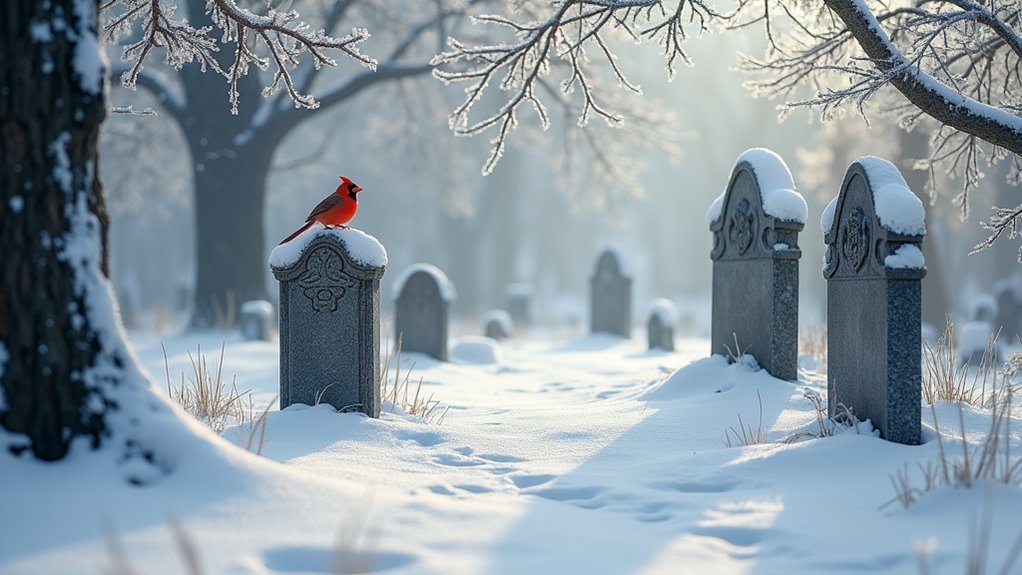



Leave a Reply